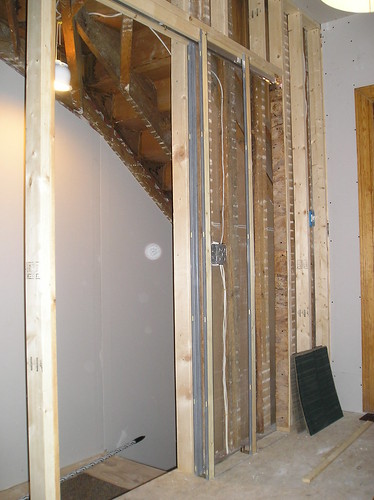Installing Pocket Door
 One way to gain extra usable space in a room is to install a pocket door. A pocket door does not use the room a standard door needs to swing out, so it provides an average of an extra ten feet of usable floor space. Here is how to install a single pocket door.
One way to gain extra usable space in a room is to install a pocket door. A pocket door does not use the room a standard door needs to swing out, so it provides an average of an extra ten feet of usable floor space. Here is how to install a single pocket door.If you choose to paint the door while it’s in the pocket, be sure to paint both sides of the door, especially if it’s got a hollow core. If you paint only one side, the moisture alone will warp the door. Cut out for the handle before you paint; you may find it easier to make this cut with the door lying between sawhorses. One last point—install adhesive on the bottom of the pocket frame where it rests on the floor (this, of course, depends on the frame’s structure). A strong bond to the floor will help stop the pocket from movement.
Reinforce the pocket structure by installing two sets of pocket door "stiffeners" (thin metal supports supplied with the kit). One set, called jamb stiffeners, is first attached to the header, plumbed up and then fastened to the floor. Another pair of stiffeners is positioned and attached in the middle of the pocket framing. The instructions that come with your pocket door kit will explain precisely where these stiffeners, called side-split jambs, need to be installed.
The most important thing is to realize what the pocket door may be sharing with the standing wall. It’s possible that the wall on either side of the framing as well as above the door will enclose electrical lines, air ducts, and plumbing. With new construction or larger remodeling projects , this may not be an issue, as you can flush this out ahead of time on your own or with the help of a remodeling contractor But with an existing wall, don’t swing a single sledgehammer before determining if these elements exist and if they can be relocated. Once that’s complete, you will need to do some deconstruction prior to installing a pocket door to adjust the door frame and jamb. Steps for Installation
Pocket doors are special types of doors that slide inside a space or compartment when opened. It gives people the illusion that it is not there to begin with making it very popular amongst homeowners who want to save space. It was designed more than a decade ago for this purpose, but it was during the Victorian period when it became a favorite. It was mainly utilized for the library, dining area, or sitting room. Its popularity continued until it completely dropped out from the consciousness of house owners and architects. The comeback of pocket doors.
kitchen for small spaces bathroom glass door bathroom glass door